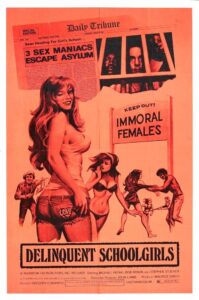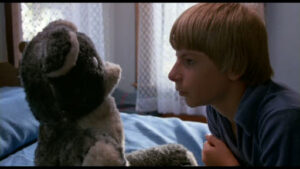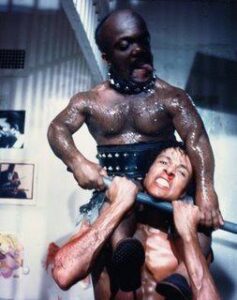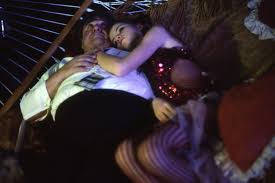Media Funhouse favorites: trash classics in search of a cult
Part two
(First published in the Dark Horse Comic “Otis Goes Hollywood” in 1997 under the title “Welcome to Hellywood”; used with the written permission of the author and the publication of first instance.)
By Ed Grant
 Delinquent Schoolgirls (1974; Veston, out of print) A relic from the brazen 1970s–when you could make jokes about pretty much anything without fear of recrimination–this T&A comedy is lewd and sexist throughout, but it also has a playful, self-mocking attitude that renders it refreshingly gauche in this era of political correctness. The plot is simple: a trio of horny fugitives from a mental asylum wander onto the campus of a women’s college attended solely by over-developed coeds. The three inmates are each stereotypes: the leader (Michael Pataki) is a nightclub impressionist; his followers are a perpetually aroused black athlete (Bob Minor) and a limp-wristed gay (the late Stephen Stucker of Airplane fame). Pataki gleefully overplays his role, actually delivering some fairly credible celebrity impressions in the process. The women are all shapely, perky dimwits who are seen exercising without bras, swimming in see-through suits, and practicing karate without panties. Rest assured, though, the film’s approach to stupidity is even-handed: the guys are simpleminded twits, too. Minor’s character announces his sole ambition in life when he announces in one tranquil interlude, “I want some pussy!” (I never said it was subtle.) Pataki’s character has slightly more esoteric ambitions: once he’s taken all the girls in the karate class hostage, he demands that they form a chorus line and execute high-kicks like the Rockettes (but without panties, of course). Since women’s lib was already on the scene by the time this movie appeared in grindhouses around the country, the movie closes with the karate chicks beating the hell out of Pataki and his mates. And just to properly identify the film’s year of production (and date the flick forever), Schoolgirls ends with a Dick Nixon joke.
Delinquent Schoolgirls (1974; Veston, out of print) A relic from the brazen 1970s–when you could make jokes about pretty much anything without fear of recrimination–this T&A comedy is lewd and sexist throughout, but it also has a playful, self-mocking attitude that renders it refreshingly gauche in this era of political correctness. The plot is simple: a trio of horny fugitives from a mental asylum wander onto the campus of a women’s college attended solely by over-developed coeds. The three inmates are each stereotypes: the leader (Michael Pataki) is a nightclub impressionist; his followers are a perpetually aroused black athlete (Bob Minor) and a limp-wristed gay (the late Stephen Stucker of Airplane fame). Pataki gleefully overplays his role, actually delivering some fairly credible celebrity impressions in the process. The women are all shapely, perky dimwits who are seen exercising without bras, swimming in see-through suits, and practicing karate without panties. Rest assured, though, the film’s approach to stupidity is even-handed: the guys are simpleminded twits, too. Minor’s character announces his sole ambition in life when he announces in one tranquil interlude, “I want some pussy!” (I never said it was subtle.) Pataki’s character has slightly more esoteric ambitions: once he’s taken all the girls in the karate class hostage, he demands that they form a chorus line and execute high-kicks like the Rockettes (but without panties, of course). Since women’s lib was already on the scene by the time this movie appeared in grindhouses around the country, the movie closes with the karate chicks beating the hell out of Pataki and his mates. And just to properly identify the film’s year of production (and date the flick forever), Schoolgirls ends with a Dick Nixon joke.
 The Pit (1981; Embassy HV; now New Line HV). On the surface, it’s just another horror flick about a lonely kid who gets revenge on his enemies. But The Pit derails very early on to become a frenzied portrait of a preteen boy’s massive sexual urges. Jamie (Sammy Snyders) is considered strange by kids and adults alike, but his ancient, carnivorous, pit-dwelling beast buddies (nicknamed “Tra-la-logs”) like him just fine. One day he discovers he’s run out of meat to feed them, so his enemies suddenly start “falling” into the creatures’ lair.
The Pit (1981; Embassy HV; now New Line HV). On the surface, it’s just another horror flick about a lonely kid who gets revenge on his enemies. But The Pit derails very early on to become a frenzied portrait of a preteen boy’s massive sexual urges. Jamie (Sammy Snyders) is considered strange by kids and adults alike, but his ancient, carnivorous, pit-dwelling beast buddies (nicknamed “Tra-la-logs”) like him just fine. One day he discovers he’s run out of meat to feed them, so his enemies suddenly start “falling” into the creatures’ lair.
In the meantime, however, Jamie’s vacationing parents have left him in the care of an attractive and concerned “babysitter.” His obsession with seeing a nude woman reaches a fever pitch as he drops his silverware on the floor to see up her skirt and checks her out in the shower while he writes “I Love You” on the bathroom mirror. The fact that this young woman walks around the house in a sheer shortie nightshirt AND bathes the boy only adds to his horniness. (Classic dialogue from the bath scene: “Do you know why my mother washes me so much? …Is she really trying to make me clean?”) But Jamie isn’t alone in his pursuit of a quick peek; he’s guided by his anthropomorphic teddy bear (Snyders supplies the bear’s “psycho” voice). The bear comes up with the brilliant idea to rig up a tape-recorded message at a pay phone in order to convince Jamie’s school librarian that her daughter has been kidnapped. In order to get her kid back, the bear argues, she’ll have to bare her breasts in the front window of her house. Jamie gets some nice Polaroids of the event and proudly shows them to “Teddy,” who comments, “I’m gonna look at these a lot!”
Sure, the film is supposed to be centered around the “Tra-la-logs,” and the filmmakers remember this about midway through, redirecting their energies toward serving up some fairly standard, craftsman-like horror scenes (after squeezing some goofy laughs out of Jamie’s attempts to feed his hairy friends). It’s important to remember, however, that in many cases, schlock movies become truly memorable because their creators introduce bizarre tangents in order to pad out the running time, or because they got carried away by their material. The makers of The Pit were guilty on both counts, and the film is gem as a result.
 Night Train to Terror (1985; Prism HV. Out of print) Though the joys of this deranged little item have been documented by other genre specialists, it still hasn’t received its rightful place in the schlock pantheon. The most bizarrely imaginative patch-job ever done, Night Train strings together scenes from three separate horror movies (one unreleased, two flops) with an ingeniously simple (and wonderfully silly) frame device wherein God and the Devil sit together in the compartment of a train arguing over the fate of mankind. The two deities decide to take a look at a few case studies, so they gaze off into the train windows through which, naturally enough, the cheapjack horror flicks appear.
Night Train to Terror (1985; Prism HV. Out of print) Though the joys of this deranged little item have been documented by other genre specialists, it still hasn’t received its rightful place in the schlock pantheon. The most bizarrely imaginative patch-job ever done, Night Train strings together scenes from three separate horror movies (one unreleased, two flops) with an ingeniously simple (and wonderfully silly) frame device wherein God and the Devil sit together in the compartment of a train arguing over the fate of mankind. The two deities decide to take a look at a few case studies, so they gaze off into the train windows through which, naturally enough, the cheapjack horror flicks appear.
But God and the Devil aren’t the train’s only passengers–a band of “musicians” consisting of several freshly scrubbed lily-white teen types wearing Flashdance-era ripped sweats, headbands, and valley-girl frocks are seen, singing and (what else) breakdancing in the next compartment. The “stories” that the two immortal beings present for our entertainment are shoddy indeed, with the highlights provided by an array of bargain-basement special effects. It’s hard to choose a favorite among these piss-poor fx, but I’d have to opt for the beheading of “Night Court” star Richard Moll (he makes a lovely howling noise just before his noggin flies), and the roasting of a Jimi Hendrix clone in an electric chair.
Yes, there are several things that distinguish Night Train from other horror anthologies, not the least of which is its scripter’s pedigree. Philip Yordan was a well-known Hollywood screenwriter who wrote Anna Lucasta (1949) and the cult favorite Johnny Guitar (1954) before he became better known around Tinseltown as a front for blacklisted writers. Yordan’s later titles were almost entirely no-budget genre pictures (including one search-for-Bigfoot opus), most of which show up on the same sell-through shelves on which Night Train can regularly be found. While Yordan might have written all three “tales” and the frame device for the film, we should note that one Charlene Brown came up with the song performed by the whitebread flashdancers: “Daddy’s in the living room/sorting through the news/Mama’s at the shopping mall/buying new shoes/Everybody’s got something to do/Everybody but you!” This song serves as a kind of anthem for those of us who have made searching for enjoyably bad movies our life’s work. And let us not forget to mention that the lead singer/breakdancer is played by a certain “Byron Yordan.”
 Penitentiary III (1987; Warner Bros.) Not only does filmmaker Jamaa Fanaka have one of the coolest-sounding names in cinema history, but he’s also made one of the only prison dramas that openly confronts the issue in every man’s mind when he embarks upon a life of crime: the inevitable “initiation” he’ll undergo behind bars. Here, the ineffable Leon Isaac Kennedy lands in jail once more, this time because, unbeknownst to him, a sneering albino gangster (played by Anthony Geary!) wants him to participate in the prison’s boxing tournament. Geary is tended to by his cellmate, a fully decked-out drag queen named Cleopatra (Jim Bailey). But Cleo isn’t even Fanaka’s most inspired creation–that distinctive character is introduced with the ominous line, “you know the Thud gonna have his ass tonight.” It seems that Geary has an extra-special way of keeping independently-minded inmates such as Kennedy on his side: the unruly party is visited after dark by a creature called “The Midnight Thud,” who will proceed to strip said rebel of his manhood.
Penitentiary III (1987; Warner Bros.) Not only does filmmaker Jamaa Fanaka have one of the coolest-sounding names in cinema history, but he’s also made one of the only prison dramas that openly confronts the issue in every man’s mind when he embarks upon a life of crime: the inevitable “initiation” he’ll undergo behind bars. Here, the ineffable Leon Isaac Kennedy lands in jail once more, this time because, unbeknownst to him, a sneering albino gangster (played by Anthony Geary!) wants him to participate in the prison’s boxing tournament. Geary is tended to by his cellmate, a fully decked-out drag queen named Cleopatra (Jim Bailey). But Cleo isn’t even Fanaka’s most inspired creation–that distinctive character is introduced with the ominous line, “you know the Thud gonna have his ass tonight.” It seems that Geary has an extra-special way of keeping independently-minded inmates such as Kennedy on his side: the unruly party is visited after dark by a creature called “The Midnight Thud,” who will proceed to strip said rebel of his manhood.
The Thud is actually a midget (played by the Haiti Kid, a midget wrestler and one-time pal of Mr. T.) who growls like a dog, can literally fly over his victims with kung-fu smoothness, and is kept on a leash (a series of low-angled shots from his p.o.v. reveal the astonished looks of those who gaze upon him). Once again, it’s important to stress that Fanaka may have just intended the movie as just another cellblock saga, but when you hear the cry of ” Thud, break ‘im in for me!” as the midget attempts to make Kennedy submit, any attempt at a Freudian analysis could be called redundant.
In an even more bizarre twist, the midget is transformed towards the end of the movie into a Burgess Meredith-like coach character who offers mystical counsel (“I will show you magic”) and practical training secrets to prepare Kennedy for his final no-rules battle. Fankaa’s execution of the final fight scene is so over-the-top (Kennedy leaves a cross-like pattern of blood on the wall as Geary yells “crucify him!”) that one could easily assume that he’s kidding. But the cliched rouse-the-crowd final minutes indicate that he’s not…which makes it that much better.
 Babe! (1980; Metropolitan Entertainment; no American HV release. Aka Hey Babe!) Yes, this one’s all about a talking pig. But it doesn’t take place in a barnyard–the porcine performer in this case is a very unsavory-looking Buddy Hackett. Hackett plays a a broken-down ex-vaudevillian who becomes the mentor of a rambunctious twelve-year-old played by future “Baywatch” lifeguard Yasmine Bleeth. Babe! veers off, though, in an uncomfortable direction as its very young heroine is dressed up in different disco-glitz and glam new-wave outfits and placed in a number of more-than-slightly-suggestive situations.
Babe! (1980; Metropolitan Entertainment; no American HV release. Aka Hey Babe!) Yes, this one’s all about a talking pig. But it doesn’t take place in a barnyard–the porcine performer in this case is a very unsavory-looking Buddy Hackett. Hackett plays a a broken-down ex-vaudevillian who becomes the mentor of a rambunctious twelve-year-old played by future “Baywatch” lifeguard Yasmine Bleeth. Babe! veers off, though, in an uncomfortable direction as its very young heroine is dressed up in different disco-glitz and glam new-wave outfits and placed in a number of more-than-slightly-suggestive situations.
In fact, despite its hoary old-fashioned show-biz storyline, the film can best be decribed as a pedophilic fantasy. (Still, even most convicted child molesters look more respectable than an unshaven, sweaty Buddy Hackett—he’s a long way from The Music Man). Bleeth looks disturbingly young than her character’s stated age, and for some reason, sports large bags under her eyes. Perhaps writer-director Rafal Zielinski felt this would convey her worn, “aged” status. In any case, the poor kid is so desperate to get into the Academy of Performing Arts that she decides to get money by performing a striptease for the boys in her youth hostel (both the Academy and the hostel are supposed to be NYC institutions, but are obviously located in Montreal, where most of the film was shot). She is stopped before she gets down to the bare essentials by the hostel’s concerned coordinator.
The strip sequence is a blatant example of the movie’s pedophilic attitude; far scarier are the scenes that take place after Bleeth flees the hostel to shack up with Buddy (an earlier moment where a broadly-smiling Hackett haunts her on a city bus provides enough nightmarish imagery to make adult viewers cringe in disgust for the duration). When Buddy arrives late for a candelit dinner the little girl complains that she’s been slaving over the meal all day. The two have fantasies of dancing together in a theatrical show: Buddy dreaming of them as Astaire and Rogers; Bleeth seems them as a glittery disco phenomenon. The duo perform in Central Park (or Montreal’s equivalent thereof) with the child wearing bizarre KISS-like face makeup (an outtake shown under the closing credits has her in full blackface!). The kid takes a bubblebath out in the middle of Buddy’s apt., and in an even more disturbing twist, scrubs Buddy’s back as he takes one. The relationship between the two reaches a head after Buddy compliments her on her progress at the Academy one night and she says in a tone of starstruck adulation, “I love you, you old goat…and I want to prove it to you.” The heavily made-up little girl (wearing a vaudeville outfit complete with garters and heels) begins to take down the sleeves of her dress, saying, “I want you to be the first.” The broken-down old stumble-bum refuses her offer, giving her a speech about waiting until the right guy comes along; in the process, of course, any viewer who hasn’t hit the fast-forward button has either collapsed from laughter or is experiencing serious nausea.
I don’t have the space to elaborate the film’s other enjoyably tacky elements, including director Zielinski’s artsty lighting schemes which bathe the characters in primary colors and a chase down supposed NYC streets involving a motorcycle with a sidecar! Despite its frantically happy ending, this is one of the scariest movies ever to come out of Canada.
< Private Obsession. (1995; Triboro) Considering the amount of straight-to-video features being cranked out these days–the majority of which are either kickboxing vengeance scenarios or unsexy erotic thrillers–I feel compelled to recommend the only one which supplied me with an ample amount of “happy pain.” This gonzo item, which comes from Lee Frost, the same filmmaker who gave us The Black Gestapo back in the ’70s, is a ludicrous variation on the storyline of The Collector.
Private Obsession. (1995; Triboro) Considering the amount of straight-to-video features being cranked out these days–the majority of which are either kickboxing vengeance scenarios or unsexy erotic thrillers–I feel compelled to recommend the only one which supplied me with an ample amount of “happy pain.” This gonzo item, which comes from Lee Frost, the same filmmaker who gave us The Black Gestapo back in the ’70s, is a ludicrous variation on the storyline of The Collector.
The aggressively melodramatic Michael Christian (imagine William Shatner or Adam West on a bad day) plays an ardent sexist who kidnaps an outspoken feminist supermodel (you know the kind) played by Shannon Whirry and imprisons her in his house. Monitoring her continually with video cameras and preaching to her through a closed-circuit TV hookup, he hopes to “deprogram” her and turn her into an old-fashioned girl.
As with any genuinely original movie that’s so-bad-it’s-brilliant, Private Obsession scores major points with its tangents–including a nearly pointless subplot about a detective (Bo Svenson) searching for the missing supermodel, and a truly horrifying bit of comic relief in which a totally bald Rip Taylor plays a gay travel agent who regales Christian with his sexual exploits. The film’s true triumph in bad taste is a scene in which the very bosomy Whirry is seen stuck in the doggy-door part of the entrance to her high-tech jail cell following one of her many doomed attempts to escape Christian’s clutches. Besides the fact that this tableau is one of the most imaginative (and stupid-looking) images ever put on film, director Frost’s uncanny knack for ridiculousness has the scene progressing to the point where Christian gets to smear margarine on Whirry’s chest and back in order to facilitate her slipping back through the narrow opening.
At certain points, it does become evident that the humor here is intentional. But as the picture progresses, and Whirry has sex with her paunchy, middle-aged captor not just once but twice, it’s clear that Frost’s primary mission is to deliver the requisite amount of nudity (even if it’s paunchy, middleaged nudity) and also to give Whirry a few minutes of control over Christian at the film’s end, just so that all the scenes where she’s been dominated would have a fitting payoff. Ah, the subtle charms of trash filmmaking….
c. 1997, 2013 Ed Grant
Ed would like to thank two people who introduced him to some of the movies found in this article (both of whom have sat through their share of clinkers): M. Faust of Buffalo’s Mondo Video and Bob Fingerman.